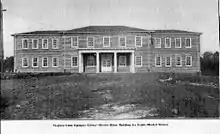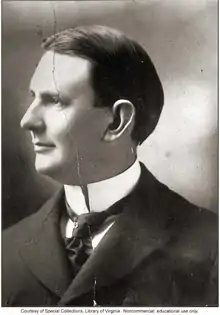Virginia State Colony for Epileptics and Feebleminded
The Virginia State Colony for the Epileptics and Feeble Minded was a state run institution for those considered to be “Feeble minded” or those with severe mental impairment. The colony opened in 1910 near Lynchburg, Virginia in Madison Heights with the goal of isolating those with mental disabilities and other qualities deemed unfit for reproduction away from society.[1] The colony was the home of Carrie Buck, the subject of the landmark Supreme Court case Buck v. Bell.[2]

History of the Colony
The colony was authorized by a 1906 bill written by eugenicist and social welfare advocate Aubrey Strode, in collaboration with eugenicists Albert Priddy and Joseph DeJarnette.[4] The colony received its first patients in 1911 and by the end of the calendar year had more than 150 men who suffered from epilepsy, a condition of social abhorrence.[4] Colonies like the Virginia State Colony had been established in order to separate the disabled from criminal populations, for example, many of the first inhabitants of the Virginia State Colony had previously been housed in prisons and state hospitals.[4] Originally, only men could be patients of the colony, but after roughly one year of operation, superintendent Albert Priddy allowed women into the colony who were diagnosed as feeble-minded.[4][2] In accordance with the change in potential patients, the colony changed from its original name, the Virginia Colony for Epileptics to the Virginia Colony for Epileptics and Feebleminded in 1914.[5]

Dr. Albert Priddy and Carrie Buck
Dr. Albert Priddy, a central figure in the legalization of the sterilization of the mentally feeble was the first superintendent of the colony.[1] Priddy had long been a proponent of sterilization as a potential method for controlling the harm the feeble minded could have on a society.[6][1] Priddy in fact performed roughly 80 sterilizations between 1916 and 1917 and thought that these procedures yielded favorable results.[6] Carrie Buck, a poor, pregnant teenager from a broken home arrived at the Colony on June 4, 1924.[6] Her mother, Emma Buck was already a patient of the colony, thus joining both mother and daughter in the camp.[1] Priddy sought Carrie to be a patient of the camp as a way to showcase eugenic ideas of heredity to support Virginia's sterilization law and eventually move the law all the way up to the supreme court.[7][1] The three generations of the Buck family and Carrie's impending sterilization became the focus of the landmark supreme court case Buck v. Bell. Dr. Priddy died before the case reached the Supreme Court, but nonetheless on May 2, 1927 the Supreme Court decided that Virginia's sterilization law was constitutional.[8][9]
Post Buck v. Bell
Following the decision upholding the constitutionality of Virginia's sterilization law in 1927, sterilizations began to take place at the Virginia Colony itself.[7] Carrie Buck was sterilized on October 19, 1927 and this began a long run of sterilizations at the colony.[10][5] In the six years following the decision in Buck v. Bell, the state of Virginia performed 1,333 sterilizations.[11] The last reported sterilization at the colony occurred in 1956.[5] Shortly after the death of Dr. Priddy in 1926, Dr. John Bell took over as superintendent of the Virginia Colony.[12] Under his leadership, the colony not only doubled in size, but increased its educational efforts to aid the feeble-minded population of Virginia.[12] The name was changed to Lynchburg State Colony in 1940, Lynchburg Training School and Hospital in 1954, and since 1983, has been known as the Central Virginia Training Center. The records of Central Virginia Training Center can be found at the Library of Virginia.[13]
Segregation
The Virginia State colony was a center for feeble minded whites only. Blacks were not admitted to the colony throughout its early years. However, the state of Virginia in 1939 created the Petersburg Colony for the care of blacks who were deemed either “insane” or “feebleminded.”[14] The poorly-funded colony was a work camp for its 182 patients who were deemed as having “borderline intelligence.”[15][16]
Contemporary Usage
The institution has remained integral in the treatment of those with mental disabilities in the State of Virginia. Now known as the Central Virginia Training Center, the institution's mission statement emphasizes, "The Central Virginia Training Center is committed to providing effective, compassionate and individually responsive services to persons with intellectual disabilities...empowering safe, healthy and enriched lives for the individuals in our care."[17] Additionally, the facility functions as an assisted living center and holds classes for some of its patients with the hope of eventual community placement.[2] As of December 2018, The Central Virginia Training Center has 65 patients and is scheduled to close in June 2020.[18]
References
- Vendatam, Shankar (2018-04-23). "Emma, Carrie, Vivian: How A Family Became A Test Case For Forced Sterilizations". npr.org. Retrieved 2019-09-23.
- Noll, Steven. "The Public Face of Southern Institutions for the 'Feeble-Minded.'" The Public Historian, vol. 27, no. 2, 2005, pp. 25–41. JSTOR, www.jstor.org/stable/10.1525/tph.2005.27.2.25
- "Central Virginia Training Center, History".
- Lombardo, Paul A.. Three Generations, No Imbeciles : Eugenics, the Supreme Court, and Buck v. Bell, Johns Hopkins University Press, 2008. ProQuest Ebook Central, https://ebookcentral.proquest.com/lib/vand/detail.action?docID=4398321
- "CVTC Feedback Page". www.cvtc.dbhds.virginia.gov. Retrieved 2019-10-04.
- Lombardo, Paul A.. Three Generations, No Imbeciles : Eugenics, the Supreme Court, and Buck v. Bell, Johns Hopkins University Press, 2008. ProQuest Ebook Central, https://ebookcentral.proquest.com/lib/vand/detail.action?docID=4398321
- "Virginia Eugenics". www.uvm.edu. Retrieved 2019-10-04.
- "Buck v. Bell." Oyez, www.oyez.org/cases/1900-1940/274us200. Accessed 5 Nov. 2019.
- Popenoe, Paul, "The Progress of Eugenic Sterilization" (2009). Buck v Bell Documents. p.22 Paper 41. http://readingroom.law.gsu.edu/buckvbell/41
- Lombardo, Paul A.. Three Generations, No Imbeciles : Eugenics, the Supreme Court, and Buck v. Bell, Johns Hopkins University Press, 2008. ProQuest Ebook Central, https://ebookcentral.proquest.com/lib/vand/detail.action?docID=4398321
- Popenoe, Paul, "The Progress of Eugenic Sterilization" (2009). Buck v Bell Documents. p.22 Paper 41. http://readingroom.law.gsu.edu/buckvbell/41
- Rowe, Frederick B, Crews, W David, and Finger, Frank W. “John N. Buck (1906–1983): Did He Practically Establish Clinical Psychology in Virginia?” Journal of clinical psychology. 49.3 (1993): 428–434. Web.
- "A Guide to the Records of the Central Virginia Training Center, circa 1909-2000s". Virginia Heritage. Retrieved 8 May 2014.
- Noll, Steven (April 1991). "Southern Strategies for Handling the Black Feeble-minded: From Social Control to Profound Indifference". Journal of Policy History. 3 (2): 130–151. doi:10.1017/S0898030600004826. ISSN 1528-4190.
- Dorr, Gregory Michael. “Segregation's Science: Eugenics and Society in Virginia.” The University of Virginia Press, 30 Sept. 2019, https://www.upress.virginia.edu/title/3722.
- "Petersburg State Colony for the Negro Insane Historical Marker". www.hmdb.org. Retrieved 2019-10-04.
- "CVTC Mission Statement". Central Virginia Training Center. 2014-01-13. Retrieved 2019-11-03.
- Faulconer, Justin. "CVTC: Counting down to closure in Amherst". NewsAdvance.com. Retrieved 2019-10-04.